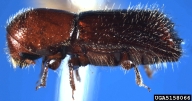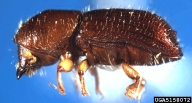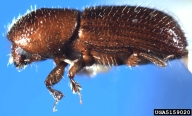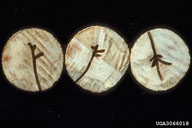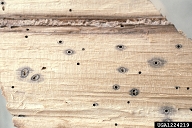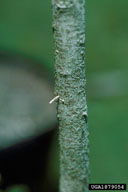Ambrosia beetles
Xyleborus spp. (Coleoptera: Curculionidae, Scolytinae)
Orientation to pest
Xyleborus ambrosia beetles are a genus of wood-boring beetles that carry fungi that colonize their galleries and serve as food for their larvae. Other genera of beetles that have similar symbiotic relationships with fungi are also referred to as ambrosia beetles. The genus Xyleborus appears to be a collection of poorly related beetles that is in need of revision. As currently constructed, there are at least 17 species in the United States and Canada (16 in the eastern United States), mostly native but with several invasive species. Many of these species breed in both coniferous and deciduous trees and shrubs of all sizes. Trees preferred for attack are ones that are unhealthy, dying, or that have recently been wounded or felled. Dead areas in living trees can also be attacked. Because this group of beetles inoculate their larval galleries with wood-decay fungi, which are eaten by their larvae, these beetles are able to make their larval galleries in heartwood (a zone of low nutrition), in contrast to bark beetles, which feed in the more nutritious sapwood. Notes on the biology and distribution of five species of Xyleborus are given here. Many new invasive species within this group have been detected recently in North America. One invasive species, the redbay ambrosia beetle (Xyleborus glabratus Eichhoff), is discussed in a separate page.
| Species | Comments on Biology and Gallery Shape |
|---|---|
| Xyleborus celsus Eichh. | The largest member of the genus in the United States, this species' galleries extend directly into the wood to a depth of 12 to 18 mm, then branch one or several times |
| Xyleborus ferrugineus (F.) | Galleries similar to X. celsus but smaller; galleries may also be longer, more winding, and branch less frequently. |
| Xyleborus affinis Eichh. | Galleries consist of elongate tunnels, off of which many transverse galleries branch. |
| Xyleborus xylographus (Say) | Attacks are commonly initiated at edges of wounds, deep crevices, or burrows made by other insects. Galleries run obliquely across the grain to depths of an inch or more. |
Hosts commonly attacked
| Species | Hosts |
|---|---|
| Xyleborus celsus Eichh. | Breeds in dead, dying, and recently felled trees and stumps of hickory |
| Xyleborus ferrugineus (F.) | Breeds in dead, dying, or felled trees of a wide range of species including oak, hickory, ash, cypress, walnut, pine, beech, and sweetgum. |
| Xyleborus affinis Eichh. | Breeds in dying trees and in green logs and lumber of various hardwood trees such as oak, hickory, sweetgum, river birch, hackberry, mimosa, persimmon, cypress, and black locust. Very destructive of sweet gum in southeastern United States along the Gulf of Mexico. |
| Xyleborus xylographus (Say) | Attacks the lower portions of dying trees and the stumps, roots, and slash of its hosts. Found especially in oak, but also in hickory, chestnut, walnut, and pine. |
Distribution
| Species | Distribution |
|---|---|
| Xyleborus celsus Eichh. | Found in eastern United States, west to Kansas |
| Xyleborus ferrugineus (F.) | Occurs from New York and Michigan, south to Florida and Texas |
| Xyleborus affinis Eichh. | Occurs in eastern United States east of a line from Michigan to Texas and south of New York |
| Xyleborus xylographus (Say) | Occurs in eastern Canada and in the United States, west to Kansas |
Images of ambrosia beetles
| Figure 1. Adults of Xyleborus celsus (left), Xyleborus ferrugineus (middle), and Xyleborus xylographus (right) | ||
| Figure 2. Galleries of Xyleborus celsus in cross sections of hickory (Carya) stems, showing intial deep pentration in the wood, with formation of branched galleries in the heart wood. | Figure 3. Cross-sectional views of galleries of Xylosandrus germanus (Blandford) in pecan. | Figure 4. "Toothpick" frass ejected from bore hole of Xylosandrus crassiusculus (Eichhoff) |
Important biological control agents related to this pest species
Natural enemies of these beetles are poorly known.
Articles
- Atkinson, T. H., R. J. Rabaglia, and D. E. Bright. 1990. Newly detected exotic species of Xyleborus (Scolytidae) in eastern North America, with a revised key to species. The Canadian Entomologist 122: 93-104.
- Haack, R. A. 2006. Exotic bark- and wood-boring Coleoptera in the United States: recent establishments and interceptions. Canadian Journal of Forest Research 36 (2): 269-288.
